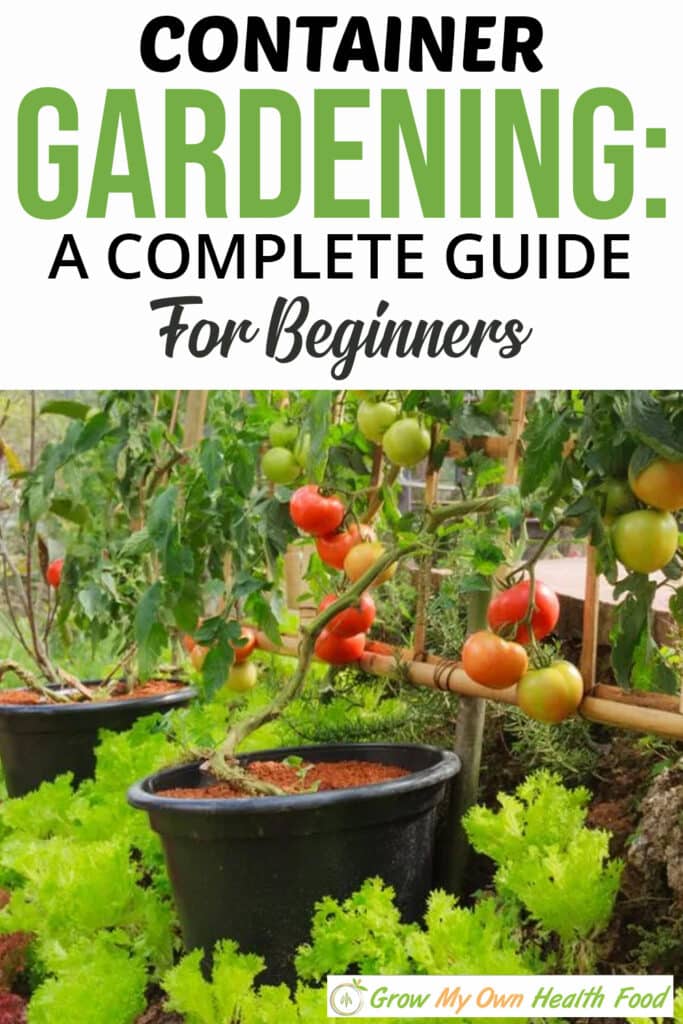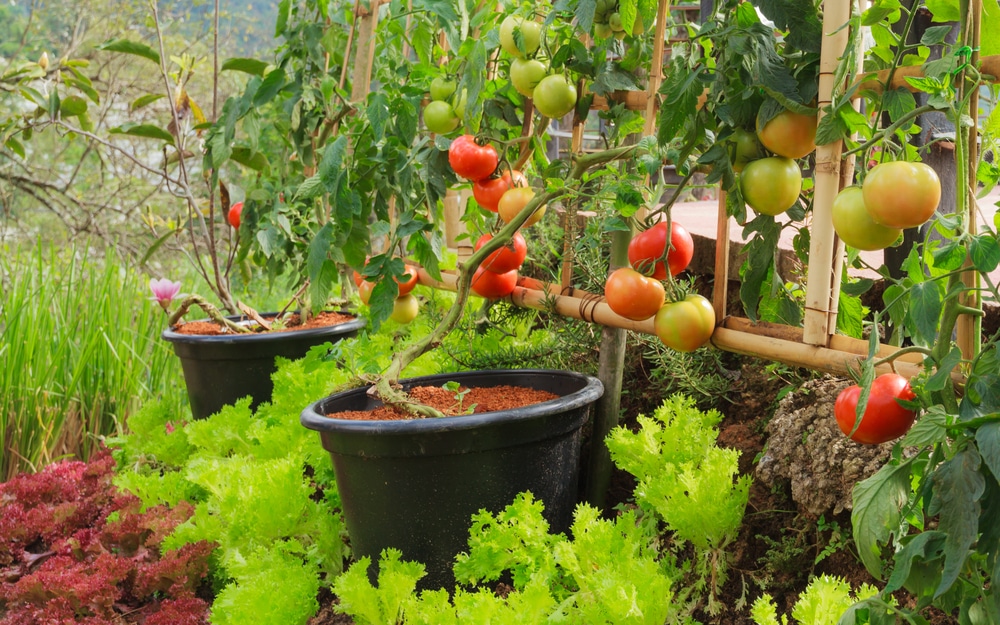Whether you don’t have a backyard to grow in or the soil in your yard is nothing but hostile to plants, container gardening offers an excellent opportunity to grow your own food. With pots, you can take your garden anywhere – imagine a balcony or patio crammed with homegrown vegetables, or a green rooftop loaded with fresh edibles!
Starting container vegetable gardening is rather simple. Whether you have a green thumb or not, this post will guide you through all the steps to have a thriving potted garden that gives a bountiful harvest each time.
What Can You Grow In Containers?
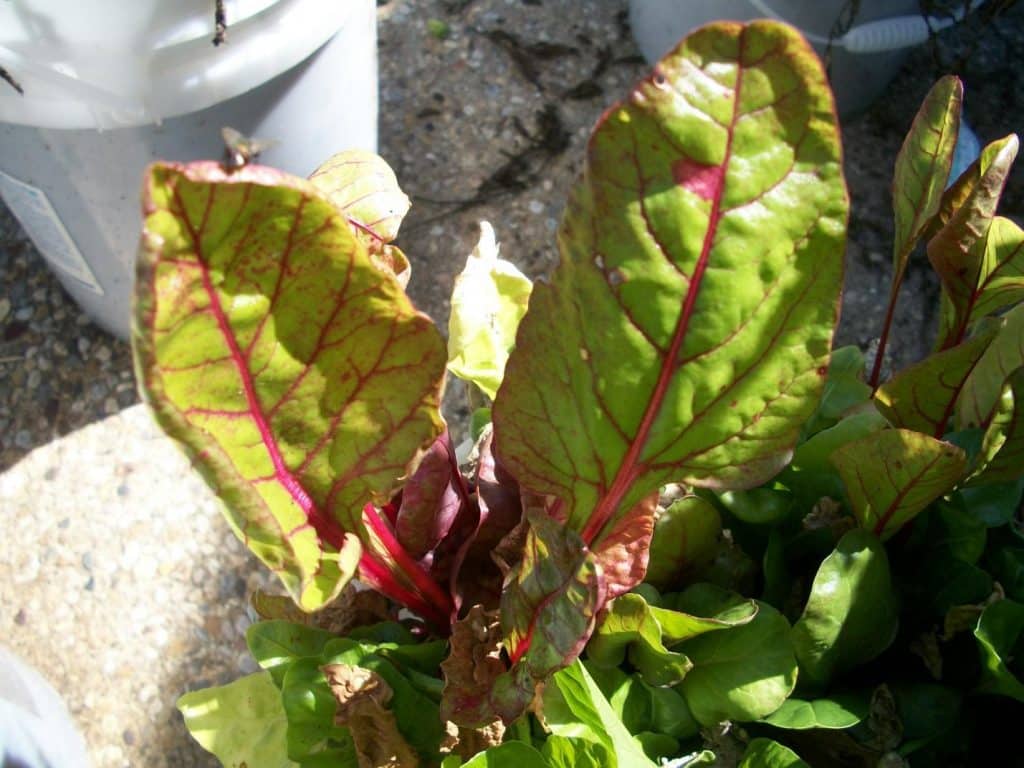
Many people don’t start container gardening since they don’t realize the true potential it holds. Pots aren’t just good enough for herbs; if you choose the right size, there are plenty of vegetables, and even fruits, that will thrive in your container garden!
Here’s a list of edibles that can easily grow in pots together with the suitable size of containers for them:
- Herbs: Grow in a pot with a minimum of 6 inches diameter.
- Eggplant: Grow 3 plants per 20-inch container.
- Green beans: Grow in a 5-gallon window box.
- Carrots: Choose a pot that’s 6 to 15 inches deep (according to carrot variety).
- Radishes: Choose 6 inches deep pot for most varieties.
- Broccoli: Grow one plant per 5-gallon pot or 2 to 3 plants per 15-gallon pot.
- Peppers: Grow a single plant per 2-gallon pot.
- Tomatoes: Grow one plant per 5-gallon bucket.
- Lemons: Grow one small tree per 5-gallon bucket
- Lettuce: 6 inches deep pot will work.
- Garlic: Choose a 6-inch deep pot, big enough to allow 6-inch spacing between cloves.
- Onion: Select an 8-inch pot for harvesting green onions, larger (3-inch spacing between bulbs) for bulb onions.
- Cucumbers: Grow one plant per 5-gallon pot.
- Blueberries: Choose a container that’s 24 inches deep and 24 inches wide for mature plants.
- Strawberries: Choose a container that’s 8 inches deep and 12 inches in diameter.
- Kale: Grow one plant per one-gallon pot, 2 per 5-gallon pot.
- Potatoes: Plant 4 to 6 seed potatoes in a 16-inch deep container with 16 inches diameter.
- Spinach: Grow 3 plants per 2-gallon pot, 10 plants/10-gallon container
Vegetables that won’t work well in containers:
- Pumpkins
- Corn
- Large squash
Container Gardening For Beginners: Tips For Success
Several vegetables and herbs will grow as happily in pots as they would in a garden – or possibly better if they get the right conditions. Here are some handy tips for container gardening for beginners to set your plants off on the track to success:
1. Select the right container
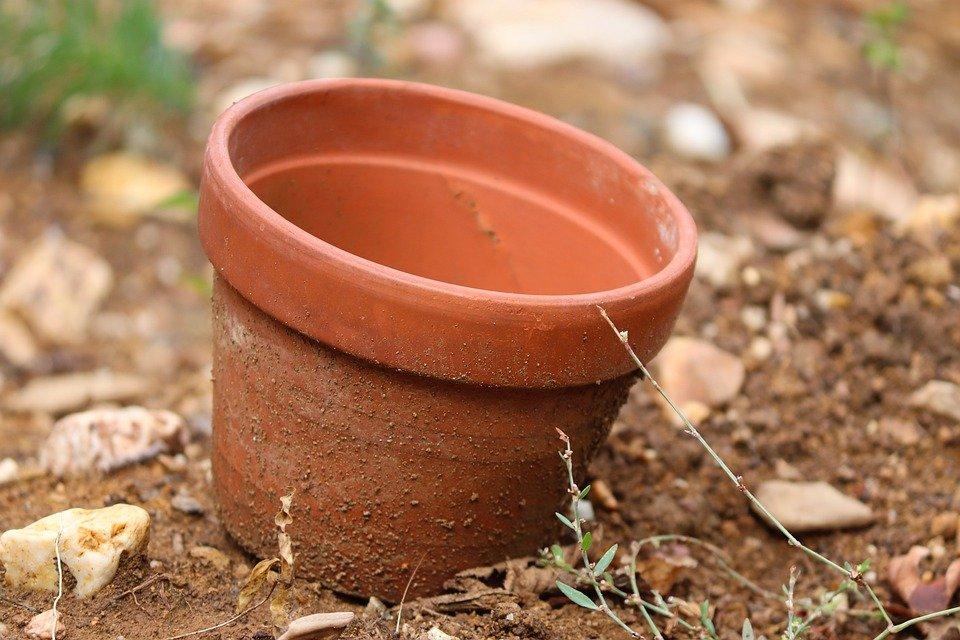
Container vegetable gardening begins with choosing the right container. We’ve already highlighted the suitable sizes of containers for most vegetables earlier in the post.
If you choose a larger pot, around 24 inches in diameter, you can grow vegetables that take more space, like pepper, tomatoes, cucumbers, or green beans. If you have smaller pots to work with, herbs, kale, lettuce, or even strawberries will do nicely.
When in doubt regarding the pot size, follow this simple rule: the bigger, the better. Bigger pots allow more room for the roots to develop and can retain more moisture, which is especially helpful on hot days.
Other than the container size, there are plenty of varieties to choose from. As long as it’s made from food-safe material, has ample drainage holes at the base, and can hold enough soil, it’s excellent for your veggie garden. If you’re living in a hot climate, avoid using metal or dark-colored pots, or you’ll literally cook your plants!
Here are some options you’ll find:
- High quality terracotta,High fired, Smooth texture
- PERFECT DESIGN: They flare out at the top which makes them stackable for more space-efficient storage.A hole in the bottom allows excess moisture to drain out to prevent over watering.
- EASY TO USE AND REUSABLE: These terracotta clay pots are high quality with beautiful finish. Made of Top-Quality clay and baked at 980℃ high temperature, lightweight and hold up to lots of use.
- IDEAS FOR PARTY FAVORS OR DECORATION: These mini terracotta pots are great for any Do It Yourself party favors or decoration, They can be used for wedding favors, place cards, baby shower gifts,..
- CREATIVE AND PRACTICAL:These Mini Terracotta Pots easy to paint for labeling and personalizing. You can use beautiful and interesting hand painted complete this fun pot! For Succulent, cactus, herbs or some other plants grow and thrive
Prices pulled from the Amazon Product Advertising API on:
Product prices and availability are accurate as of the date/time indicated and are subject to change. Any price and availability information displayed on [relevant Amazon Site(s), as applicable] at the time of purchase will apply to the purchase of this product.
The most widely used are the traditional terracotta pots. They’re attractive but expensive and breakable. In northern areas, you’ll need to take them indoors in winters to prevent cracking.
- Classic whiskey barrel planter in a Distressed Oak finish with antique pewter colored bands
- UV coated finish protects color from fading
- Lightweight and durable high density resin construction
- Delivered with drainage holes for outdoor use
- Top diameter 15, Height 10.25, Bottom diameter 9 - Weight 1.3 lbs
- Volume: 4.75 gall
Prices pulled from the Amazon Product Advertising API on:
Product prices and availability are accurate as of the date/time indicated and are subject to change. Any price and availability information displayed on [relevant Amazon Site(s), as applicable] at the time of purchase will apply to the purchase of this product.
Wooden planters give your container garden a classy look and aren’t too expensive for optimal sizes. Choose rot-resistant wood so you can use it for several growing seasons.
- Round food storage containers are economical, durable, and easy to use
- Heavy Duty - All Purpose - 90 Mils Thick (.09)
- Lids included. Lids fit snugly to create an air resistant food saving seal.
- Available in 5 Gallon Volume
- Proudly made in the U
Prices pulled from the Amazon Product Advertising API on:
Product prices and availability are accurate as of the date/time indicated and are subject to change. Any price and availability information displayed on [relevant Amazon Site(s), as applicable] at the time of purchase will apply to the purchase of this product.
5-gallon plastic buckets are one of the cheapest options to start container gardening for beginners. You’ll easily find these at hardware stores and can drill holes at the base, if they’re not already present.
- RAISED GARDEN BED KIT Vegepod Raised Garden Bed Kits are simply the easiest way to grow your own vegetables. You get the size of a raised garden bed with all the benefits of container gardening. The base contains the soil so neighbouring trees don’t steal nutrients.
- SELF WATERING: Vegepod is self-watering, meaning it utilises a wicking system where the soil draws the water upwards keeping it moist. Established plants can last weeks without watering and in cooler times your plants may not require water for months at a time.
- PROTECTIVE COVER: Each Vegepod comes with a Vegecover which protects the plants from harsh sun and creates a perfect micro-climate, providing a superior growing environment. Also protects the plants from bugs/ pests and animals.
- ASSEMBLY & WARRANTY: With the modular design, setup is really easy. Assembles in about 20 minutes. Can be easily raised to 39.4in height with a Vegepod Stand. Comes with a 10 years warranty
- A SERIOUS VEGETABLE GARDEN: Large Vegepod is a serious vegetable garden, large enough to grow any vegetables you want. Container Size: 78.7in x 39.4in (2m x
Prices pulled from the Amazon Product Advertising API on:
Product prices and availability are accurate as of the date/time indicated and are subject to change. Any price and availability information displayed on [relevant Amazon Site(s), as applicable] at the time of purchase will apply to the purchase of this product.
Perfect for forgetful waterers, self-watering containers are large and make it effortless to grow your own food. You just have to keep the reservoir full, and the container will handle the rest.
2. Set Up The Garden
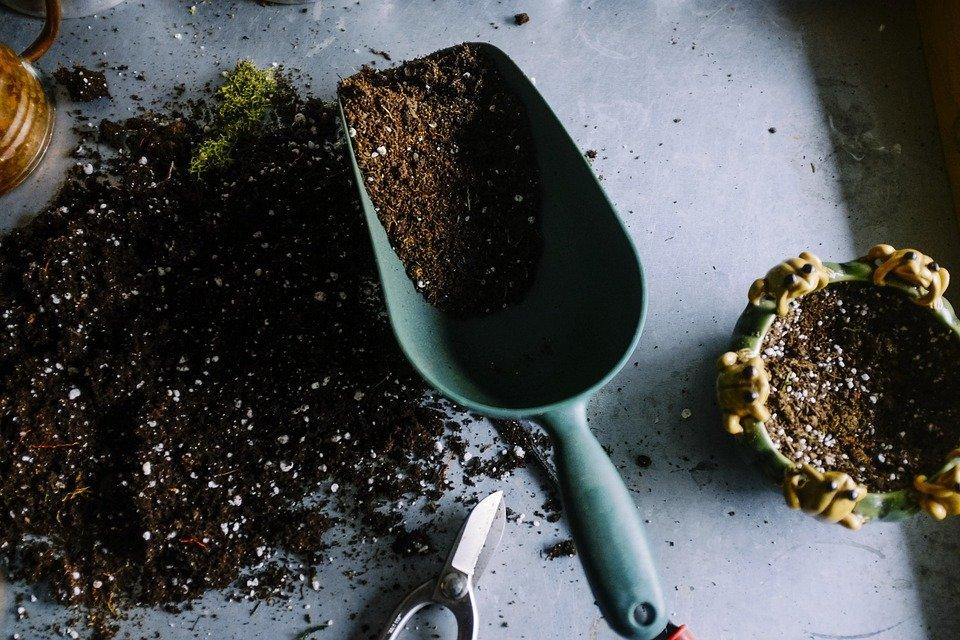
Once you’ve selected the vegetables and picked the right container for growing them, it’s time to set up the potted garden. Just follow these steps for container gardening:
- Position the pots
Once you fill the pots, they’re going to be heavy and difficult to move, especially the larger ones. Place them at the right location before starting. Most vegetables need full sun. Make sure they’re at a spot where they get bright sunlight for several hours each day. Leafy vegetables, like chard, spinach, kale, and lettuce won’t mind growing in partial shade.
- Create good drainage
If your pot doesn’t already have drainage holes at the base, drill a large hole in the center, or several small holes throughout the base. Cover them with newspaper or coffee filters to prevent losing dirt from the bottom.
You can also consider double-potting for keeping your plants cool in peak summers. Just place the pot inside another larger pot and fill the space between them with newspaper. Soak the newspaper each time you water the plants.
- Fill them up
Don’t fill your pots with your regular garden soil, since it’s too heavy for container vegetable gardening. It will become compacted and won’t drain well for proper plant development. Also, you’ll be transferring garden weeds to your potted garden with this soil. Instead, use a high-quality potting mix for filling the containers. Don’t fill them to the rim with soil mixture. Leave some space for watering.
- Plant the seeds/seedlings
Starting from seeds is the most economical option, and it lets you explore some unique varieties that you don’t usually find otherwise. However, you can skip some of the wait and hard work by getting seedlings or young plants from the local nursery and transplanting them to your container. Water the soil and make sure it’s evenly moisty before planting anything in it.
Starting from seeds
When choosing seeds, be sure to select disease-resistant varieties to lower the chances of crop failure. Plant densely and cover the seeds with a thin layer of soil, ¼ to ½ inches deep to ensure fast germination.
Make sure they have a warm spot, receive plenty of sunlight, and have evenly moist soil until sprouting. Once the seedlings develop their first set of true leaves, you can thin them to maintain the required spacing for the type of plant you’re growing.
Starting from seedlings
You can also start from transplants purchased at the local nursery. Choose a healthy-looking plant that’s labeled for disease-resistance. Transplant them carefully to your pot, making sure you don’t damage the delicate roots. Prepare a hole in the new pot, place the plant, and cover the root ball with soil to the same level as it was in its original pot. Don’t press the dirt or you’ll compact it and diminish its drainage.
3. Garden Care
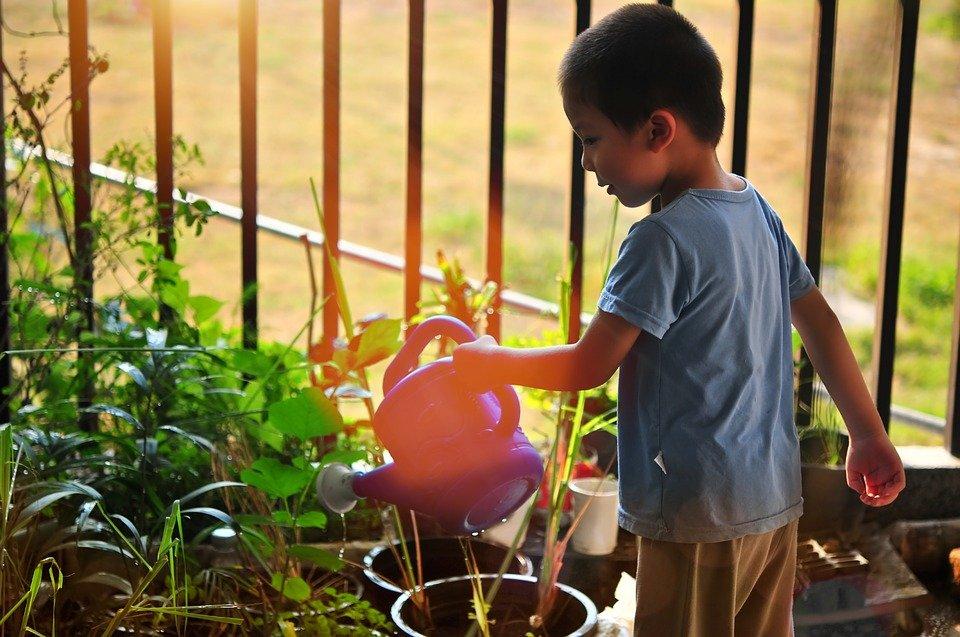
Now that you’re knee-deep in container gardening, maintain your plants well to help them flourish. After all, you’ll be the one to benefit when it’s harvest time! Here are some handy tips to help your potted garden thrive:
- Water regularly
Watering is even more critical with container gardening than it is with regular gardening. This is because containers are less capable of holding moisture than the ground. Check your plants regularly and water them when the top 2 inches feel dry to touch. On hot summer days, you may need to water them twice a day to prevent heat stress.
- Fertilize as required
Container plants are also more specific about their feeding requirements. Preprepared potting mixes usually have sufficient fertilizers in them to keep the plants well-fed for the first couple of weeks. After the first 3 to 4 weeks, start fertilizing them every two weeks with diluted fish emulsion or compost tea.
- Some plants need support
Vining plants will need a trellis to climb on as they grow. They’ll keep the plants well-supported, contained, and healthy to boost production. If you’re growing cucumbers, pole beans, or tomatoes, install a trellis at the time of planting to avoid disturbing the roots once the plants develop.
Conclusion
So that’s about it. You now have all the basics of container gardening for beginners. There’s nothing left to do but gather your supplies and get your hands dirty! Follow all the tips, and in just a few months, you’ll see what it’s like to pick fresh homegrown vegetables from the container garden you created entirely on your own!
